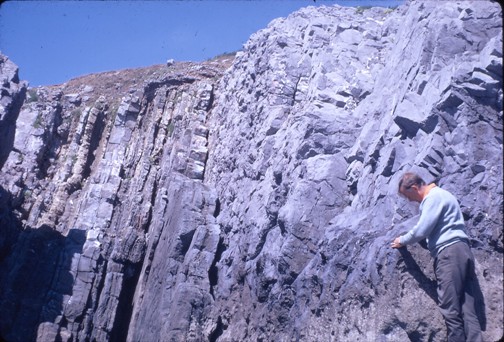
Caption: Bill Ramsbottom examining the Goniatite Bed at the top of the Caswell Bay Oolite and the junction with the overlying Caswell Bay Mudstone, both of Chadian age, in Three Cliffs Bay, Gower, South Wales: 6 August 1971. The slide was taken during a
visit to South Wales by the Geological Society's "Dinantian Working
Group".
It was immediately after this visit that Bill recognised that variations of water depth in the Carboniferous Limestones of Gower (first noted by E E L Dixon in 1912) could be used to define a sequence of major cycles to subdivide and, with their contained faunas, correlate the Dinantian rocks of Britain.
The meeting in Leeds was organised at the University of Leeds by the Yorkshire Geological Society and the Leeds Geological Association, with support from the Geological Society of London, and was attended by over 100 people, ranging from ex-colleagues of Ramsbottom from the British Geological Survey to amateur geologists and members of the general public.
There were four speakers at the Leeds meeting. The first was Bilal Haq, (National Science Foundation, Washington DC) one of the pioneers in the development of sequence stratigraphy. He gave an eloquent tribute to Ramsbottom, showing how Ramsbottom’s work had anticipated almost all of the fundamental ideas of sequence stratigraphy. He then went on the discuss the problems still facing the determination of past sea levels, concentrating on the Palaeozoic, and highlighting the difficulties of back stripping the sedimentary record to yield the environment at the time of deposition. The hardest problem turns out to be estimating the water depth at which sediment had been formed.
Mike Simmons and colleagues (Neftex) presented the results of their detailed analysis of sequences around the world, with the identification of 114 first, second and third order maximum flooding surfaces and associated sequence boundaries. His group is convinced that the major control on sea level is by freezing and melting of continental ice sheets, even in the periods in the Mesozoic which have traditionally been thought to be ice-free.